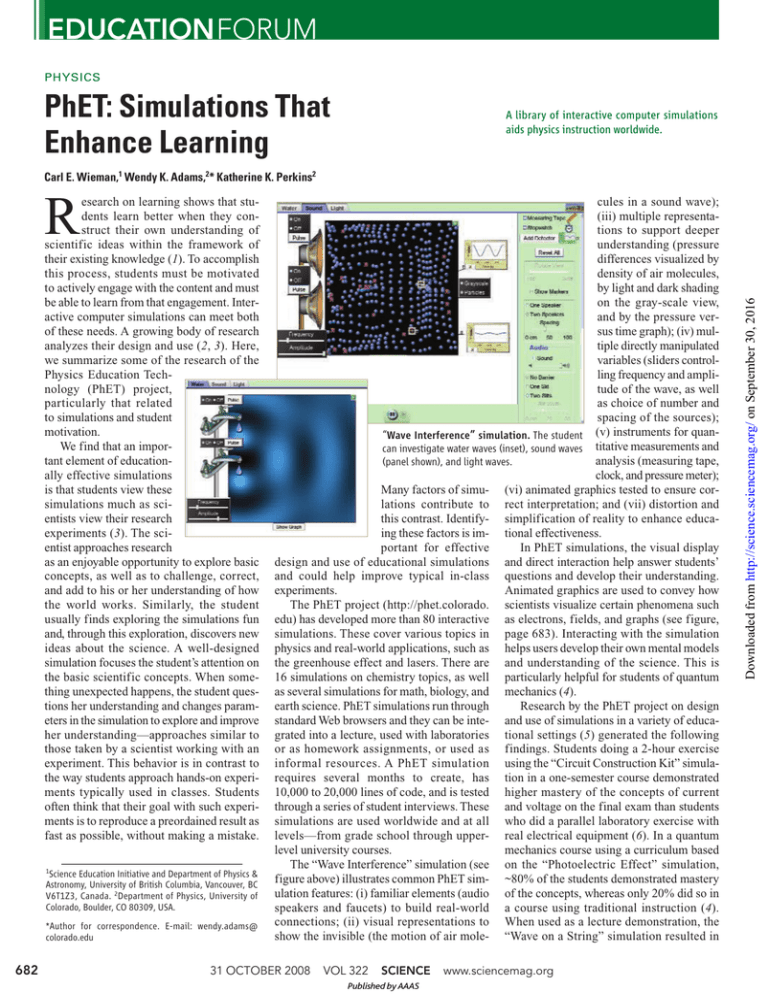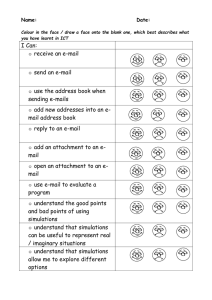PhET: Simulations That Enhance Learning
advertisement

EDUCATIONFORUM PHYSICS PhET: Simulations That Enhance Learning A library of interactive computer simulations aids physics instruction worldwide. esearch on learning shows that students learn better when they construct their own understanding of scientific ideas within the framework of their existing knowledge (1). To accomplish this process, students must be motivated to actively engage with the content and must be able to learn from that engagement. Interactive computer simulations can meet both of these needs. A growing body of research analyzes their design and use (2, 3). Here, we summarize some of the research of the Physics Education Technology (PhET) project, particularly that related to simulations and student motivation. We find that an important element of educationally effective simulations is that students view these simulations much as scientists view their research experiments (3). The scientist approaches research as an enjoyable opportunity to explore basic concepts, as well as to challenge, correct, and add to his or her understanding of how the world works. Similarly, the student usually finds exploring the simulations fun and, through this exploration, discovers new ideas about the science. A well-designed simulation focuses the student’s attention on the basic scientific concepts. When something unexpected happens, the student questions her understanding and changes parameters in the simulation to explore and improve her understanding—approaches similar to those taken by a scientist working with an experiment. This behavior is in contrast to the way students approach hands-on experiments typically used in classes. Students often think that their goal with such experiments is to reproduce a preordained result as fast as possible, without making a mistake. R 1Science Education Initiative and Department of Physics & Astronomy, University of British Columbia, Vancouver, BC V6T1Z3, Canada. 2Department of Physics, University of Colorado, Boulder, CO 80309, USA. *Author for correspondence. E-mail: wendy.adams@ colorado.edu 682 cules in a sound wave); (iii) multiple representations to support deeper understanding (pressure differences visualized by density of air molecules, by light and dark shading on the gray-scale view, and by the pressure versus time graph); (iv) multiple directly manipulated variables (sliders controlling frequency and amplitude of the wave, as well as choice of number and spacing of the sources); “Wave Interference” simulation. The student (v) instruments for quancan investigate water waves (inset), sound waves titative measurements and analysis (measuring tape, (panel shown), and light waves. clock, and pressure meter); Many factors of simu- (vi) animated graphics tested to ensure corlations contribute to rect interpretation; and (vii) distortion and this contrast. Identify- simplification of reality to enhance educaing these factors is im- tional effectiveness. portant for effective In PhET simulations, the visual display design and use of educational simulations and direct interaction help answer students’ and could help improve typical in-class questions and develop their understanding. experiments. Animated graphics are used to convey how The PhET project (http://phet.colorado. scientists visualize certain phenomena such edu) has developed more than 80 interactive as electrons, fields, and graphs (see figure, simulations. These cover various topics in page 683). Interacting with the simulation physics and real-world applications, such as helps users develop their own mental models the greenhouse effect and lasers. There are and understanding of the science. This is 16 simulations on chemistry topics, as well particularly helpful for students of quantum as several simulations for math, biology, and mechanics (4). earth science. PhET simulations run through Research by the PhET project on design standard Web browsers and they can be inte- and use of simulations in a variety of educagrated into a lecture, used with laboratories tional settings (5) generated the following or as homework assignments, or used as findings. Students doing a 2-hour exercise informal resources. A PhET simulation using the “Circuit Construction Kit” simularequires several months to create, has tion in a one-semester course demonstrated 10,000 to 20,000 lines of code, and is tested higher mastery of the concepts of current through a series of student interviews. These and voltage on the final exam than students simulations are used worldwide and at all who did a parallel laboratory exercise with levels—from grade school through upper- real electrical equipment (6). In a quantum level university courses. mechanics course using a curriculum based The “Wave Interference” simulation (see on the “Photoelectric Effect” simulation, figure above) illustrates common PhET sim- ~80% of the students demonstrated mastery ulation features: (i) familiar elements (audio of the concepts, whereas only 20% did so in speakers and faucets) to build real-world a course using traditional instruction (4). connections; (ii) visual representations to When used as a lecture demonstration, the show the invisible (the motion of air mole- “Wave on a String” simulation resulted in 31 OCTOBER 2008 VOL 322 SCIENCE Published by AAAS www.sciencemag.org Downloaded from http://science.sciencemag.org/ on September 30, 2016 Carl E. Wieman,1 Wendy K. Adams,2* Katherine K. Perkins2 greater conceptual learning than did the real equipment frequently stopped to ask standard demonstration (2). questions of the Teaching Assistant (TA) that We have also conducted more than 250 indicated concerns over hurting themselves interviews of individual students using or breaking the equipment. The simulation PhET simulations in a think-aloud format. groups rarely asked questions of the TA and These interviews reveal how and why stu- were constantly discussing within their peer dents interact with simulations and how groups and trying various circuit configurathis interaction leads to learning (7, 8). tions to test their ideas. In another study, First, students find the simulations to be we used the simulations “Moving Man,” fun and intellectually engaging. Students “Projectile Motion,” and “Energy Skate (and teachers) will spontaneously play for Park” to supplement the use of laboratory hours with some simulations in education- equipment. Students expressed a strong ally productive ways. We have identified a preference for simulations over the real number of characteristics that make a sim- equipment. They repeatedly commented that ulation this engaging, many of which are it was easier to see what was happening with what make video games engaging (9). the simulations and that they were more fun These include (i) dynamic visual environ- than the real equipment. In contrast, unexments that are directly controlled by the pected results with the real equipment were user, (ii) challenges that are neither too commonly blamed on human error or defechard nor too easy, and (iii) enough visual tive equipment, and there was very little complexity to create curiosity without exploration. We heard numerous comments being overwhelming. Items (ii) and (iii) are about how it was nice that the simulations best developed through iteration and test- were always correct and they (the students) ing with students. could not break them, as they could the real We find that students are not able to equipment (10). make sense of the science in the simulation As scientists, we perceive our experijust from watching. They must interact ments through an “expert filter” arising actively with the simulation. Most of the from our extensive experience and knowllearning occurs when the student is asking herself questions that guide her exploration of the simulation and her discovery of the answers. When students engage in such self-driven exploration, they learn better. For example, nonscience students with no prior knowledge of physics are able to provide quite good explanations of an electromagnetic wave after less than an hour playing with the “Radio Waves” simulation. (Even physics majors have a hard time explaining electromagnetic waves after a year of physics.) Faraday Laboratory. In a series of panels, students explore bar This sort of self-driven explo- magnets and electromagnets, induced currents, transformers, ration is very similar to what a and, finally, hydroelectric power generation. scientist does with an experiment. It is the students’ perceptions of the simula- edge, and this perception allows us to see tions that encourage them to explore in a our experiment much the way these students similar manner. Students have little fear of perceive PhET simulations. As scientists, we breaking the simulations or hurting them- recognize the important aspects of the appaselves, and they trust the simulations to be ratus and ignore the trivial, so it is neither correct. Some learning goals are not overwhelmingly complex nor frightening. addressed through the simulations, such as We perceive challenges that engage us to operating complex laboratory equipment (3). carry out exploration and discovery. In the study comparing the use of A good simulation provides the student “Circuit Construction Kit” with equivalent with the equivalent of training wheels on a real equipment (5), students were observed bicycle, effectively substituting the conto do more spontaneous experiments with straints and display of the simulation for the simulation than with the corresponding expertise. This support allows students to real electrical equipment. Groups using the carry out exploration and learning that is www.sciencemag.org SCIENCE VOL 322 Published by AAAS cognitively similar to that of a scientist, something they do not have the experience or motivation to do with most real equipment in physics. With real equipment, the numerous complex unknowns are mysterious, uncontrollable, and threatening. Without an “expert filter,” every detail is seen as equally important. For example, we have seen students in electric circuit laboratories spend considerable time worrying about the significance of the (irrelevant) color of plastic insulation on the wires. We also see in simulation testing how rapidly expert-like understanding can change a person’s perception. With the “Radio Waves” simulation, if students are initially faced with the full-field view, they are overwhelmed. They find the simulation unpleasant, and they are reluctant to interact with it. However, if a student begins with the standard simple start-up panel, they will readily explore and develop an understanding so that, when they later encounter the full-field view, they understand it and actually prefer it. Simulations can therefore be designed to introduce students to increasing levels of complexity and messiness, which may be an effective and engaging way to prepare students for real scientific research. Carefully developed and tested educational simulations can be engaging and effective. They encourage authentic and productive exploration of scientific phenomena, and provide credible animated models that usefully guide students’ thinking. References and Notes: 1. J. Bransford, A. Brown, R. Cocking, Eds., How People Learn: Brain, Mind, Experience, and School (National Academy Press, Washington, DC, 2000). 2. K. K. Perkins et al., Phys. Teach. 44, 18 (2006). 3. See supporting material available on Science Online for additional information. 4. S. B. McKagan et al., Am. J. Phys. 76,406 (2008). 5. All research papers by the PhET team can be found at: http://phet.colorado.edu/new/research/index.php. 6. N. D. Finkelstein et al., Phys. Rev. Spec. Top. Phys. Educ. Res. 1, 010103 (2005). 7. W. K. Adams et al., J. Interact. Learn. Res. 19, 397 (2008). 8. W. K. Adams et al., J. Interact. Learn. Res. 19, 551 (2008). 9. T. Malone, Cogn. Sci .5, 333 (1981). 10. Student perception of the accuracy of simulations is a complex topic that is discussed in the supporting material. 11. The PhET work has been supported by the NSF, the William and Flora Hewlett Foundation, Microsoft, the University of Colorado, the Kavli Operating Institute, and C. Wieman and S. Gilbert. This work represents the valuable contributions of the entire PhET Team. Downloaded from http://science.sciencemag.org/ on September 30, 2016 EDUCATIONFORUM Supporting Online Material www.sciencemag.org/cgi/content/full/322/5902/682/DC1 31 OCTOBER 2008 10.1126/science.1161948 683 PhET: Simulations That Enhance Learning Carl E. Wieman, Wendy K. Adams and Katherine K. Perkins (October 31, 2008) Science 322 (5902), 682-683. [doi: 10.1126/science.1161948] This copy is for your personal, non-commercial use only. Article Tools Permissions Visit the online version of this article to access the personalization and article tools: http://science.sciencemag.org/content/322/5902/682 Obtain information about reproducing this article: http://www.sciencemag.org/about/permissions.dtl Science (print ISSN 0036-8075; online ISSN 1095-9203) is published weekly, except the last week in December, by the American Association for the Advancement of Science, 1200 New York Avenue NW, Washington, DC 20005. Copyright 2016 by the American Association for the Advancement of Science; all rights reserved. The title Science is a registered trademark of AAAS. Downloaded from http://science.sciencemag.org/ on September 30, 2016 Editor's Summary
